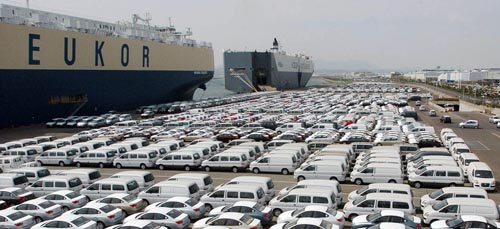Asia’s resilient economy

Hyundai cars await export at shipping terminal in Ulsan. By Song Bong-geun
Why was the South Korean economy so resilient? Because its businesses and government leaders recognized the opportunity this crisis presented. The familiar rap on South Korea is that its economy is “stuck in the middle,” trapped between an advanced Japan and a rising China. South Korea’s great dilemma - or so it’s often said - is that it falls short of Japan on quality and can’t hope to match China on price.

The depreciation of the won in 2008 contributed to South Korea’s recent export gains, but it was hardly the decisive factor in South Korean competitiveness. Rather, South Korean producers’ ability to thrive amid crisis reflects a relentless focus on improving product design and quality, as well as savvy and aggressive marketing efforts to enhance the image of South Korean brands. Less than a decade ago, Samsung Electronics was a maker of lower-end consumer electronics, barely noticeable in global markets. The company figured out how to move up the value chain by building a strong brand image and innovation. Its efforts are paying off: in 2009, Samsung ranked 19th on Interbrand’s Best Global Brands list. Samsung’s rise in ranking over the last decade was the fastest among any of the top 100 brands. It has even surpassed rival Sony, which now ranks 29th. Hyundai Motor and LG Electronics are making similar dramatic progress.
As South Koreans look to the next decade, the key question is whether they can maintain this strategic advantage. Does South Korea have the right model to withstand the inevitable next round of shocks to the global economy? Can the nation grapple with other problems that threaten long-term growth?
In pondering such questions, one thing seems clear: an attempt to compete with China on cost or scale is bound to fail. South Korea’s best hope is to move higher up the value chain. Capital investment will play a crucial role in that ascent. South Korean firms have a solid record for investing in productive capacity. Indeed, South Korea’s capital investments in research and development are among the highest in the world relative to national income. This is a strength South Korea must preserve.
South Korea’s recently announced decision to expand tax deductions for business investments in research and development is a step in the right direction. But such incentives should also look forward, targeting investments in new growth areas such as alternative energy, green technologies and biotechnology. South Korea’s comparative advantage lies in technology and design, not in resource-intensive heavy- manufacturing industries, which will inevitably lose market share to competitors in China.
In the long run, South Korea can’t rely solely on manufacturing because investments in technology-intensive industries are inherently labor saving - in other words, they do not create jobs. If South Korea is to achieve balanced, sustainable growth, it must also place greater emphasis on its labor-intensive services sector. Services employed only 66 percent of South Korea’s workforce in 2008, compared to 70 percent in Japan and 85 percent in the United States. South Korea’s 30 percent self-employment rate - among the highest of any nation in the OECD - reflects a fragmented, over-regulated services sector dominated by inefficient “mom and pop” proprietors.
The surest solutions to this shortfall are liberalization and greater openness to foreign competition in key areas such as finance, distribution, professional services and communications. At the same time, the nation must increase infrastructure investments in medical care, tourism and education.
South Korea also must focus on raising the living standards of its people and narrowing the gap between rich and poor. Growth must be distributed more equitably between urban and rural areas. Currently, Seoul and adjacent cities generate nearly half of South Korea’s GDP. The excessive concentration of South Korean growth is manifest in the nation’s property market, where prices in Seoul are climbing while prices in the rest of the nation remain sluggish. The government has used the crisis as an opportunity to accelerate regional infrastructure spending. It should complement that effort with investment policies designed to encourage the creation of regional economic clusters.
It’s always tempting to predict the future by extrapolating trends from the recent past. In the case of South Korea, that would be a serious mistake. Yes, the nation’s real GDP growth, which averaged 6.3 percent in the 1990s, declined to 5.2 percent during 2000-07 and plunged to 0.8 percent in 2008-09 in the midst of the global crisis. This downward trend has led some to warn that South Korea’s potential for economic growth over the coming decade has fallen to an annual average of as little as 3 percent.
We believe South Korea can sustain an average growth rate of 4 percent or better - provided government policy, in conjunction with private-sector strategies, focuses on three fundamentals: continued investment in R&D, services sector reform and regional development. Should South Korea take decisive action in these areas - and we suspect it will - it will emerge as one of Asia’s most impressive post-crisis growth surprises.
* From ‘Korea 2020
28 essays on Korea’s future by McKinsey & Company, Inc.
Random House Korea, Inc.
A project with the International Advisory Council to the Korean President
*Stephen Roach is chairman of Morgan Stanley; Sharon Lam is Vice President of Research at Morgan Stanley Asia
By Stephen S. Roach and Sharon Lam










with the Korea JoongAng Daily
To write comments, please log in to one of the accounts.
Standards Board Policy (0/250자)